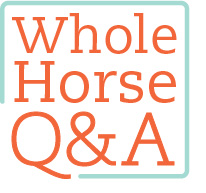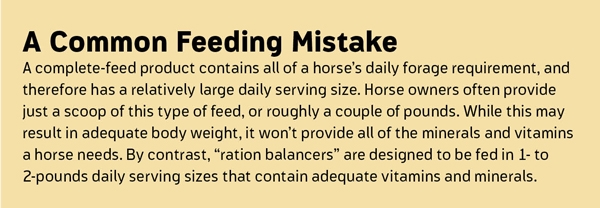Q I have a laminitis-prone Morgan mare. I keep her trim but not underweight. She’s in a stall with a paddock; I ride her 12 to 25 miles per week. I feed her one scoop of a low-carb complete feed daily, plus unlimited grass hay. She lost weight over the winter, though I blanketed her for warmth. How can I put a little weight on her this summer, and what about next winter?

PAM COUNTERMAN BIRDSELL, California
A While weight loss is typically due to lack of calories or sometimes quality protein, it’s important to eliminate other possibilities such as dental issues, internal parasites, or low-grade pain. Have your veterinarian examine your mare. If she gets a clean bill of health, look for ways to increase her calorie intake. I would ordinarily suggest first increasing the hay intake, but you’re already feeding unlimited grass hay. So instead, consider replacing about 20 percent of her grass hay with alfalfa, which has a higher calorie count and provides a slightly better quality of protein to the ration.
Whether this does the trick or not, you’re currently making a common feeding mistake—that is, feeding a complete feed at an amount far below the recommended daily intake (see box). This can have negative effect on the body condition in some horses, because they miss out on vitamins and minerals that play important roles in metabolic processes. If the diet is deficient in vitamins and minerals, then the energy and protein provided by the diet may not get used effectively.
I’m guessing you’re using the feed you are because it’s low-carb. Because you’re also feeding hay, however, a better choice would be a feed with a low, 1- to 2-pounds-daily serving size that’s also low in starch and sugar, and therefore safe for a horse with a history of laminitis. This ensures that the diet is better balanced and nutritional needs are met. In the feed industry, we call these feeds “ration balancers,” and all the major feed companies have one. They aren’t all equally low in starch and sugar, however, so you’ll need to find one that’s less than about 10-percent starch/sugar.

If your mare doesn’t gain enough condition with the switch to some added alfalfa and a ration balancer, then look for a feed with a moderate daily serving size. This will provide more calories than the ration balancer while ensuring a balanced diet via what’s still a relatively small serving size. If you feed at least 3 pounds of a product that recommends a daily serving size of 3 to 8 pounds, for example, this will provide your mare more calories than the ration balancer plus all necessary minerals and vitamins.
This diet provides some flexibility for the summer. If your horse starts to gain too much weight, you can either switch the 3- to 8-pounds-daily feed out for a ration balancer and/or remove the alfalfa hay, or vice versa next winter. Remember—whatever commercial feed you’re using, be sure to follow the feed directions provided. Otherwise, the diet may be deficient in key nutrients.
CLAIR THUNES, PhD
Summit Equine Nutrition
summit-equine.com






